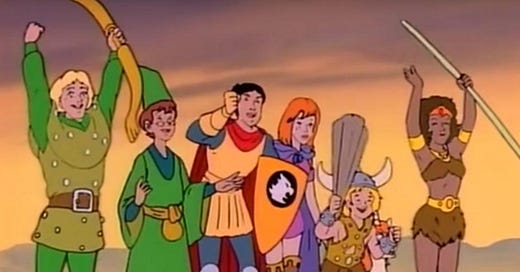What CEOs Can Learn from Wizards and Barbarians
Why game designers understand teamwork better than most executives
In 1972, Gary Gygax was 34 years old, broke, and fixing shoes to feed his five children.
He’d been unemployed for two years, trying to scrape a living from game design. In a good year, he made the equivalent of $6,000. His savings were nearly gone. By most measures, he was failing.
The thing that kept him going was the Castles and Crusades Society.
It was a tabletop gaming club, and Gary was in charge of organising fantasy wargame campaigns between multiple groups. Over time, he noticed that the games were starting to evolve from just reporting battle statistics, to creating narratives.
Interesting … he thought.
So, picking up on this shift, Gary and fellow designer Dave Arneson, joined forces to create something that had never existed before. A game where players had distinct characters with specialised abilities, who had to work together to survive.
Together, they created Dungeons & Dragons.
The world’s first RPG.
In 1974 they printed 1,000 copies for their official launch.
They sold out almost immediately.
And the rest, as they say, is gaming history.
The beauty of D&D is you don’t win by overpowering your enemies with a single character. You survive by building a party, a group of specialists, each with their own abilities and limitations. The wizard can bend time but can’t wear armour. The barbarian can soak damage but barely read. The rogue can sneak, the cleric can heal, the ranger knows the terrain.
Each one is essential.
None can succeed alone.
And most importantly. ..
You work with your abilities, not against them.
You never try to make a wizard strong. You level up their magic.
Gary and Dave understood something most CEOs still haven’t figured out.
That generic, balanced teams don’t win. The power comes from teams stacked with specialists. And each challenge requires you to create a different stack.
The system doesn’t reward homogenised teams. It rewards intelligent interdependence. Knowing what challenge you’re facing, knowing what you’re for, and trusting others for what you’re not.
Nature already knows this.
We humans are a pretty smug lot. We tell ourselves that we’re the pinnacle of evolution. That we’re independent, self-sufficient, apex predators with dominion over all other species. But biologically? We have more in common with termites than tigers.
In biology, there’s a term for this: Superorganism.
A superorganism is a system where individuals function together as a single unified entity. Species like bees, ants, and termites divide physical labour functionally. Each role is specialised, and each role plays a critical part keeps the colony alive.
There are workers and warriors.
Builders and foragers.
Queens who reproduce, soldiers who protect.
Sure, humans aren’t bees or ants. We’re all capable of working and warring, building and foraging, reproducing and protecting. Yet humans are still arguably still a superorganism, because we are a species that has evolved to divide cognitive labour functionally.
Just like bees, we evolved to be specialised, not to be interchangeable generalists. Only our specialities are cognitive. Some of us are wired to explore. Some to stabilise. Some to scan for threats, some to drive forward, some to bridge the gaps in between.
What makes our species powerful isn’t individuality, it’s interdependence.
The Apex Predator Delusion
But somewhere along the way, in Western cultures at least, we started telling ourselves a different story. That the individual is more important than the collective. That “I am” is more important than “we are”. That we are wired to compete, not collaborate. That we are, in essence, a solo act.
But that story isn’t science. It’s branding.
Evolutionarily, we are not apex predators.
We don’t have fangs, claws, speed, venom, or size.
We survived because we could collaborate, coordinate, and cognitively specialise better than anything else on Earth.
So no, we’re not like lions or tigers.
We’re more like termites with frontal lobes.
Bees with stories.
Ants with memory and language.
Yes, we are often described as a “generalist species”. And that’s because we can survive in jungles, deserts, tundra, and cities. But there’s a subtlety here. We’re not generalists because we are generalists.
We’re generalists because our species is full of specialists.
As Heather Heying and Brett Weinstein put it in A Hunter-Gatherer’s Guide to the 21st Century, our superpower isn’t balance, it’s our collective adaptation. We survive everywhere because within us are minds built for wildly different things.
Leadership Isn’t a Title. It’s a Turn.
Great teams aren’t built on homogeneity. They’re built on functional diversity, and that means different minds, adapted for different tasks, stepping forward at different times.
We know from D&D that you don’t win a dungeon crawl by asking the healer to tank the dragon. We know from evolution that you don’t build a hive by telling every bee to be the queen. And we know that you don’t lead well by expecting everyone to show up the same way, every day, for every challenge.
The smartest leaders know that leadership should shift based on the problem you're solving. Sometimes, you send in the wizard. Sometimes, the barbarian needs to lead. Sometimes, the healer holds the room together.
Sometimes it’s your turn. Sometimes it’s not.
This is distributed leadership.
It’s intelligent interdependence.
And it only works when:
You know what each brain is wired to do best.
You know what kind of problem you’re facing.
You know when to pass the talking stick.
So, if you’re running a team, don’t let the HiPPO rule the room.
Ask, whose function fits the moment?
Because when you get that right, you don’t just get more harmony.
You get more impact.




